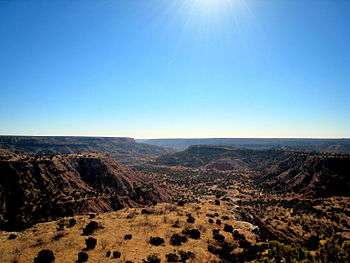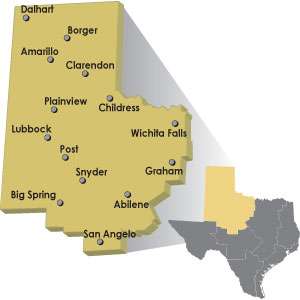Texas Panhandle
The northwest corner of Texas is known as the Texas Panhandle, probably because it juts out in stark plaintiveness from the rest of the state. Flat and dry, the steady prevailing winds can sometimes create mild dust storms, though modern farming techniques have much reduced the terrible dust storms which occurred during the "Dust Bowl Days" of the Great Depression. The region is subject to extremes of temperature like much of the Great Plains. Temperatures regularly reach 100ºF (38ºC) during the summer, while the winters can bring snows and the occasional blizzard. While the snows are not frequent, the prevailing winds can drive what little does drop across a large area of the plains until it finds something to pile up against, usually a town or city or a highway. Drifting is generally the real hazard, rather than large quantities of snow as happen in the North and East of the U.S.

Regions
| High Plains 180 degrees of sky, wheat and corn as far as the eye can see, and the rich legacy of pioneers and cowboys. |
| Llano Estacado The heart of Panhandle cotton country, with bustling Lubbock at its center. |
| North Central Plains The Texas Heartland. |
| Northern Edwards Plateau |
Cities

Other destinations
- 🌍 Palo Duro Canyon
- 🌍 Caprock Canyons State Park
- Buffalo Springs Lake
- Lake Meredith
- Lake Ransom Canyon
- Lake Alan Henry
Understand
For most outsiders visiting for the first time, the Panhandle represents a lot of what is expected of the state of Texas. Its vast prairies and open grasslands harken back to a time when the frontier was largely unexplored; a rugged, unfamiliar place with intrigue and legend hidden in its plains and canyons. The people of the region are also quite representative of what an outsider may expect, displaying the fierce independence and genuine polite courtesy that Texans are famous for.
Get in
By car

- I-20 runs through Abilene, providing a gateway to the southern Panhandle.
- US 84 leads into the Panhandle towards Lubbock and Snyder; you can get to it from I-20.
- I-40 intersects with I-27 connecting Amarillo and Lubbock to New Mexico and Oklahoma.
- US 287 connects Amarillo to the Dallas-Fort Worth area.
- US 87, US 83, US 70 & US 62/82 offer alternative routes.
Get around
In addition to Interstates 20, 27, and 40, several major US highways traverse the area, and, though the Panhandle is predominantly rural, it benefits from Texas' exemplary state highway system and remains easily navigable. It is recommended, however, that you keep a close watch on the gas gauge as you travel the Panhandle because population centers are generally spread out over a wide distance, and not all of these towns possess gas stations. The ones which do tend to close at dusk or shortly thereafter, when planning an evening drive make sure you fill up before embarking.
See
- Palo Duro Canyon, near Amarillo. The second largest in the US, Palo Duro Canyon is known for its striking natural formations and largely undisturbed beauty. Catch a performance of the musical play Texas under the stars for a uniquely Texan experience.
- Lake Meredith National Recreation Area. North of Amarillo lies the large Lake Meredith. The Lake Meredith area features several canyon systems, the Canadian River, and the lake itself, which supplies water to both Amarillo and Lubbock. Almost the entire area is free to roam for experiencing the wild Texas landscape. Rent a boat to enjoy the water, or hike through McBride Canyon for amazing views of the Canadian River.
- The Cadillac Ranch, west of Amarillo. The sight of these half-buried Cadillacs has fascinated and surprised many a curious traveler since 1974. The "sculpture" is on private land, but an up close view is welcomed and even encouraged.
- Historic Route 66. The old Mother Road parallels I-40 through the High Plains, and most of the towns it passes through have made an effort to preserve its original route.
Do
Though the Panhandle is relatively sparse in population, there is hardly a shortage of diversions and amusements for visiting guests. There is camping at Palo Duro Canyon State Park, boating and fishing on the many area lakes and reservoirs, and public park systems are abundant in the largest towns and cities in the area. For those seeking the thrill and excitement of rollercoasters and other rides, there are two parks in the region to choose from. Wonderland Park in Amarillo, the largest privately owned park in the state, boasts more than 25 rides and attractions, including the Texas Tornado double-loop rollercoaster. Joyland Park in Lubbock features several carnival-style flat rides, but also has 3 rollercoasters and a variety of water rides. Both parks charge modest entry and parking fees and have a wide variety of old-fashioned carnival eateries.
Many of the towns in the area possess small rodeo arenas where competition generally takes place on the weekends.
For avid football fans, high school football in Texas is something not to be missed. It enjoys a stature in Texas that is unrivaled in any other state and has been the subject of many feature films, books, and television shows. For a look at the real fervor that can surround the sport, one should make time to catch a game in one of the smaller towns, where it is often the most prominent diversion in the community. In towns with especially sparse populations, a six-man version of the game is played which is delightfully fast paced and high scoring. Games generally occur on Friday night, and most communities post their respective school's schedule at local restaurants and other establishments.
Eat
A visit to The Big Texan Steak Ranch is a must for any Amarillo visitor. This flamboyantly tacky display of Texan bravado wrapped in bright neon dares patrons to consume a 72 ounce steak and all of the trimmings. If you can finish it all within an hour, your meal is free.
Small, family owned diners and lunch counters can be found in many of the small towns that dot the Panhandle, and while these hidden treasures may not be glitzy or glamorous, one can count on a filling home cooked meal for a small amount of money. Few of them advertise, so a keen eye is the best way to find them.
Also, if one is looking for traditional Mexican food, avoid the large chain restaurants and find a small one. These restaurants are usually owned and operated by a single family, with much of the food and trimmings prepared from scratch.
Drink
Stay safe
Since the Panhandle is largely rural, crime is virtually nonexistent outside of the major cities. The weather, however, does require some vigilance, as the region often experiences the widest weather extremes in the state. Panhandle winters can be surprisingly brisk, and the areas at the far north end can receive significant snowfall during the winter months. Conversely, summertime high temperatures routinely top 100ºF (38ºC). Pack and dress accordingly.
Also, the Panhandle is at the tail end of Tornado Alley. It is wise to pay attention to weather reports during the spring storm season, which runs generally from March through early June.